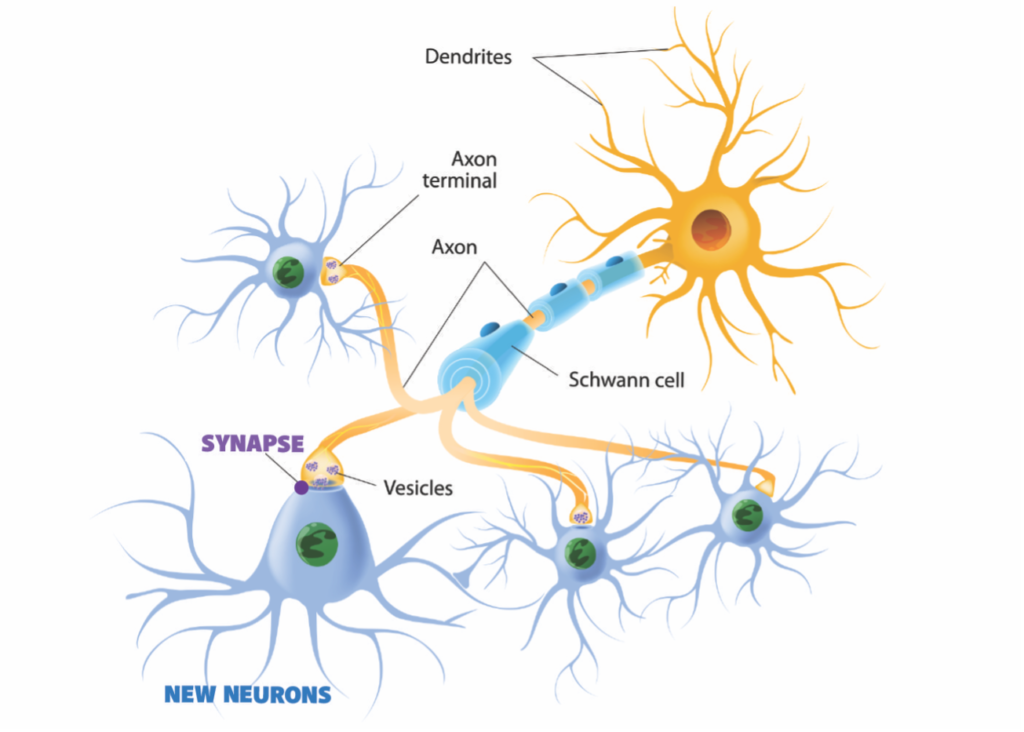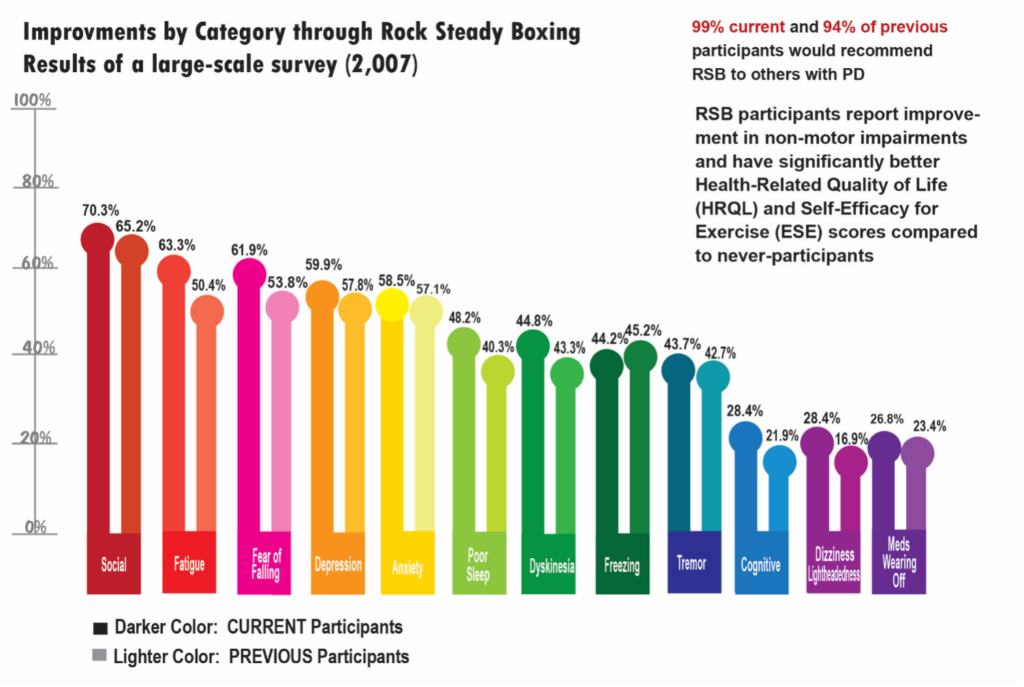Written by Kris Meldrum, BA ACE, Parkinson’s Wellness Coach, Genesis Health Clubs WDM.
Reviewed by Dr. Jay Alberts, Vice-Chair of Innovations within the Neurological Institute, holder of the Bell Family Endowed Chair, and staff in the Department of Biomedical Engineering of The Cleveland Clinic.
Exercise can profoundly change the lives of those living with neurological diseases. Even so, joining a Parkinson’s/neuro exercise program can be daunting—there is a real fear of the unknown that keeps many from realizing the meaningful benefits that could otherwise enhance their lives. I have worked with countless students over the years and have seen how exercise enables them to do things they didn’t know were possible.
I’d like you to meet a few of my students:
Jane started exercising the moment she was diagnosed with early-onset Parkinson’s. Neuro Cycling, Rock Steady Boxing (RSB), and The OhioHealth Delay the Disease™ (DTD) class became her go-tos. Jane viewed exercise as her new job. With this mindset, she and her doctor minimized the medication needed for her care. This change remained during the first four years of her Parkinson’s journey and has changed only slightly over the subsequent four years.
“I had everything to win if exercise worked and little to lose if it didn’t!” ~ Jane
My new student, Joe, came to his first neuro cycle class after his wife, Kelly, told him about the Neuro Wellness Program. He was diagnosed with Multiple Sclerosis (MS) four years ago and came to class walking with a cane. He quickly became the life of the party, making the class laugh and smile with his amazing sense of humor. He also works extremely hard in class—cycling three times each week and participating in DTD class twice weekly. Four months after beginning these classes, he no longer needs his cane.
“I have benefited from classes both mentally and physically. It is essential to have our support group. It helps to know other people have challenges to overcome and we are not alone in our daily struggles. We must work hard every day to maintain and delay the progression of our illness.” ~ Joe
Another student, Kay, joined the group after attending my Parkinson’s exercise talk at the 2021 American Parkinson’s Disease Associations (APDA) IA Chapter Optimism Conference. She remains thankful for all that exercise programs have brought to her life and is so glad she overcame her fears—especially of cycling.
“I was equally amazed by the ease I experienced starting to exercise in this program and the warmth and camaraderie I found with this exercise group. I really enjoy Delay the Disease™ and seeing my movement improve. I was scared to try cycling but was surprised to find it was fun. I feel a big difference in my motor skills immediately after cycling. I was surprised by the positive change in how I felt and moved. I feel great working hard and know I am helping my PD in the process.“ ~ Kay
Move It, Move It
For too long, people diagnosed with Parkinson’s were sent home and were told to sit and not exercise. Regrettably, we now know that such inactivity only accelerates the progression of Parkinson’s. Predictably, the 2020 COVID Pandemic decreased physical activity for those living with Parkinson’s, translating into more physical and mental symptoms. Subsequent research showed that many experienced “worsened symptoms . . .slowness, stiffness/rigidity, tremor, gait, freezing of gait, speech, easy fatigability, pain, sleep disorders, concentration, feeling stressed, anxiety–depression, constipation, and forgetfulness.”
Without exercise, Parkinson’s progresses even faster. Professor Bas Bloem, Medical Director and Neurologist at the Parkinson Center, Nijmegen, Netherlands, states that “The adverse effects of inactivity include cardiovascular disease, osteoporosis, insomnia, cognitive decline, depression, constipation, and all lead to early mortality. All of these are risk factors when you have Parkinson’s, so if you are both inactive and have Parkinson’s, your risk of early mortality is higher.”
Dr. Bloem goes on to say daily exercise is critical for those living with Parkinson’s because:
- Exercise helps your heart, brain, bone density, lungs, and more.
- Exercise may prevent Parkinson’s.
- If you have Parkinson’s, exercise works like a medication. It is continually proven by research that exercise suppresses symptoms of Parkinson’s.
- It is currently believed that if anything can slow the progression of Parkinson’s, it’s regular exercise.”
RAGBRAI 2003
RAGBRAI (Register’s Annual Great Bicycle Ride Across Iowa)—an organized cycling event in which thousands of participants bike across Iowa—forever changed treatment philosophies for Parkinson’s. A group of Parkinson’s cyclists (and their caregivers) was organized by a young research scientist who convinced them to join him in the trek across the state. That young researcher, Dr. Jay Alberts, is today the Vice-Chair of Innovations within the Neurological Institute, holder of the Bell Family Endowed Chair, and staff in the Department of Biomedical Engineering at The Cleveland Clinic.
 On the ride in 2003, positive results soon became apparent. At the end of each day, one group member proclaimed that she didn’t feel like she had Parkinson’s. Even more surprising to Dr. Alberts were improvements to her handwriting—it was bigger and more legible. Other group members experienced reduced symptoms on subsequent rides, suggesting to Dr. Alberts that further research into the effects of exercise was indicated.
On the ride in 2003, positive results soon became apparent. At the end of each day, one group member proclaimed that she didn’t feel like she had Parkinson’s. Even more surprising to Dr. Alberts were improvements to her handwriting—it was bigger and more legible. Other group members experienced reduced symptoms on subsequent rides, suggesting to Dr. Alberts that further research into the effects of exercise was indicated.
That research journey progressed from Iowa cornfields to clinical trials in 2007 to determine how the brain works to improve motor function in those living with Parkinson’s. During the clinical trial. Dr. Alberts compared two cycling groups: one group riding a tandem bike at a “forced-paced” (pedaling at a higher intensity than they usually would by themselves) versus a group riding at a “voluntary-paced” (pedaling at their own pace). While both groups improved aerobically, the VE (voluntary effort exercise) Group did not improve the Unified Parkinson’s Disease Rating Scale (UPDRS) motor scores. The FE (forced effort exercise) Group improved 35% from baseline. This group also saw substantial improvements in overall motor function—balance, tremor, stiffness, and Bradykinesia. Also, the FE Group maintained those benefits up to four weeks after they stopped cycling.
The results from the 2009 landmark study titled Forced, Not Voluntary, Exercise Improves Motor Function in Parkinson’s Disease were one of the first accurate proclamations that exercise should be part of the Parkinson’s prescription and medication for people living with Parkinson’s.
Forced Exercise
The phrase “forced exercise” is a reference to the person on the front of the tandem bike forcing the pedals to spin at a rate of 80 revolutions per minute (rpm) or higher so that the cyclists riding in the back (those living with Parkinson’s) also maintained that level of effort. It’s important to note that the cyclist in the back was actively working at their highest capacity to spin their legs: they weren’t just having their legs pushed for them—they received the benefit because they did the work.
Likewise, the Voluntary Effort Group received ZERO improvements for Parkinson’s symptoms even though they rode identical times and distances. Exercising at a pace below 70% of maximum heart rate (using the National Academy of Sports Medicine (NASM) heart rate equation) for 45 minutes is unlikely to derive the results that the FE group experienced.
That is an important distinction to understand: Those living with Parkinson’s often become discouraged at less-than-hoped-for results from regular exercise. If they aren’t experiencing results, they are likely exercising at too low of an intensity level. Unfortunately, many quit exercising because they think it’s not working. They haven’t been taught how to exercise to get their desired results.
Recommended Intensity
There is a formulaic recommendation for how exercise may inspire reductions in Parkinson’s symptoms: relative symptom improvements of up to 35% (and distinct slowing of symptom progressions) can be derived from cycling efforts at 80 rpm for 45 minutes at least three times a week. Similar intensities can be maintained through boxing, running, and walking at higher intensities. While the prospect of such intensity and duration may be intimidating, my students have all been able to do it by building up their efforts over time. Many students start with 10 minutes on the bike and ride at 50 pm. Within a few months, they are shocked to find themselves riding a 45-minute class much faster than they ever thought possible.
Whenever anyone tells me they will never be able to exercise at higher intensity levels, I introduce them to Sandy, a stroke patient who is completely paralyzed on one side of her body. It took us a few tries to get her up onto the bike, but once there, she increased both speed and time. Now, she pedals consistently between 80-90 rpm, and she can easily ride for 45 minutes. After her first two years on the bike, she gained enough leg strength that she was able to stand up in the saddle—which was her personal goal. Now, cycling is her favorite exercise.
Since his 2009 landmark study, Dr. Alberts has dedicated 18 years to researching Parkinson’s exercise, deep brain stimulation, and advanced technology for diagnosing and treating Parkinson’s.
Exercise programs like RSB and DTD were founded on the premise of Dr. Albert’s forced exercise study. Numerous research studies have continued to reinforce his work proving that “vigorous” exercise reduces symptoms of Parkinson’s (and other neurological diseases) and slows the progression of those diseases.
A 2020 research study on exercise and the neuroprotective mechanisms of neurodegeneration stated, “Recently, a meta-analysis prepared evidence on the safety and efficacy of physical exercise as an additional therapeutic intervention for the quality of life, cognition, and depressive symptoms across six chronic brain disorders. These disorders were Huntington’s disease, AD, PD, multiple sclerosis, unipolar depression, and schizophrenia. . . Considering its [exercise] effect among PD patients, it improves gait, balance, cognition, along with a slowing down progression of the disease by avoiding protein aggregation in the brain. . . Epidemiological studies have found that physical activity reduces the risk of AD and dementia by 45% and 28%, respectively.”
However, the secret to the success of exercise depends on intensity and duration, which supports Dr. Alberts’ original findings that the greater the exercise intensity, the greater the neuroendocrine response. The neuroendocrine response consists of brain, nerves, and hormones combining to affect neuroplasticity, or “rewiring the brain.”
Rewiring the Brain
So, exactly how does exercise rewire the brain? It happens through the physiological response to vigorous exercise that promotes new synapses in the brain. These new synapses then form new neurons, allowing the brain to become more efficient and/or learn new tasks (rewire). That is why DTD classes incorporate short, high-intensity rounds followed by work on Parkinson’s-specific exercises like memory, large-amplitude walking, or balance; however, neuroplasticity and brain changes are highly dependent on variables: specificity, difficulty, complexity, and intensity.
In cycling, that variable is riding a bike at a certain intensity (80 rpm or above) for changes to occur. In boxing, the intensity and complexity of movement for a specific amount of time must occur for the brain change. Rewiring the brain to lessen Parkinson’s symptoms doesn’t just happen. All these things work together in concert for the change to occur.

What happens to the brain during exercise?
What is happening in the brain during exercise? A Neuro Cycle Class, a Pedaling for Parkinson’s class, an RSB class, and a DTD class are designed to help the brain rewire for change. During aerobic exercise at higher intensity levels, muscles contract and release a hormone called Irisin. Irisin is called “the exercise hormone” (Figure 2), releasing into the brain a protein called Brain-Derived Neurotrophic Factor (BDNF). The presence of this protein is key to maintaining neurons and creating new ones (Shown in Figure 3). And what this means for those living with Parkinson’s is life-changing results.

8 Life-Changing Results from Consistent, High-Intensity Exercise
What are those life-changing results? Exercise has many positive effects on the human brain:
- Exercise improves mood and sleep.
- Exercise reduces stress and anxiety.
- Exercise reduces insulin resistance. For people with Parkinson’s, insulin causes tremor, rigidity, and Bradykinesia. Exercise reduces it!
- Exercise reduces inflammation. Chronic inflammation contributes to the condition and progression of Parkinson’s; conversely, the reduction of inflammation is a phenomenal benefit in slowing the progression of the disease.
Exercise stimulates growth and releases growth factor, considered a promising approach to neuroprotection and neurorestoration; however, using growth factor drug replacement has been found too difficult and insufficiently safe for treating Parkinson’s.
- A 2020 abstract stated, “Multiple clinical trials with [growth factor medication] GFs were performed in Parkinson’s disease (PD) patients . . . but the results of these trials are controversial” 5 (Sidorova). Fortunately, exercise is being shown to release growth factor naturally and safely.
- Exercise creates the growth of new blood vessels. A 2022 pilot trial s studying how a biological compound stimulates new blood vessel growth in the brain for people with Parkinson’s, theorizing that restoring blood flow with new blood vessels—known as angiogenesis—can slow and even reverse the progression of Parkinson’s.
- Exercise improves memory and learning (the rewiring and neuroplasticity explained in Figures 2 and 3).
- Exercise preserves brain cells’ overall health, abundance, and survival (Neuronal Survival). These are enormous benefits that have no side effects.
Cycling and Parkinson’s
Significant scientific research stands behind creating exercise programs for neurological diseases (like Neuro Cycling/Pedaling for Parkinson’s). Cycling improves motor and non-motor symptoms and improves leg strength, which is vital to help with fall prevention.
A study in 2012 reported that cycling increased muscle size and strength in both 20-year-olds and 74-year-olds. Another 2013 FE study by Dr. Alberts compared how medicine and “forced exercise” were compared through brain imaging. The results found FE improved patients’ motor functions clinical ratings by 51% compared to 33% in patients who received medication.
And remember the wonderful BDNF that helps form new synapses and creates those wonderful life-changing results? A 2020 tandem cycling research study in Colombia found BDNF levels increased more than 10-fold after high-intensity (IG) group cycling three times a week for 16 weeks.
 It is important to note that the BDNF levels decreased in the Low-Intensity Control Group. “Plasma BDNF levels increased more than 10-fold in the (Intervention Group) IG and decreased in the (Control Group) CG, a significant difference. Larger increases in plasma BDNF correlated with greater decreases in UPDRS. These findings are similar to those from previous studies showing that high-cadence tandem cycling improves motor function and mobility in patients with PD.”
It is important to note that the BDNF levels decreased in the Low-Intensity Control Group. “Plasma BDNF levels increased more than 10-fold in the (Intervention Group) IG and decreased in the (Control Group) CG, a significant difference. Larger increases in plasma BDNF correlated with greater decreases in UPDRS. These findings are similar to those from previous studies showing that high-cadence tandem cycling improves motor function and mobility in patients with PD.”
Rock Steady Boxing
Rock Steady Boxing (RSB) is a workout jam-packed with strength, power, balance, and endurance components, which is why it’s such an effective program both physically and emotionally. The exercise is based on cardinal TRAP symptoms—tremor, rigidity, akinesia, posture. In 2019, the largest survey of RSB use in Parkinson’s was conducted. RSB participants reported improvement in non-motor impairments and had significantly better Health-Related Quality of Life (HRQL) and Self-Efficacy for Exercise (ESE) compared to never-participants. (See Figure 4 to view a complete list of RSB improvement categories.)
“Exercise is increasingly recognized as an important treatment for motor and non-motor symptoms of PD . . . RSB participants report improvement in difficult-to-treat non-motor PD impairments, including fatigue, anxiety, depression, and fear of falling, as well as improvement in their social life.“

My student Don has found that when he boxes in the morning, by the time he sits to watch the evening news, his tremors have subsided even before he has taken his medication.
“My tremors are calmed down. I could even say exercise eliminates them. That’s a pretty bold statement, but it definitely takes it back to ground zero.” ~ Don

Delay the Disease
Delay the Disease (DTD) is a Parkinson’s-specific exercise program that helps students minimize their Parkinson’s symptoms. DTD creates an environment that promotes support, community, and camaraderie. Each class includes short episodes of high-intensity aerobic work followed by Parkinson’s-specific task training: core stability, strength training, dual-task training, integrated cognitive challenges, fine motor drills, balance training, etc. These tasks are incorporated at a challenging level of difficulty for all functional abilities.
As mentioned earlier, DTD uses brief bursts of cardio to get the brain activated to work on Parkinson’s-specific activities. This makes it a great compliment to other more cardio-based classes like neuro cycle and RSB, where the cardio portion is much longer. Because DTD cardio is only about 15 minutes total—and is broken up into three segments—I have had students who were not getting the kinds of motor results they were expecting. They wanted the results others experienced from neuro cycle and RSB, but the class didn’t incorporate long enough cardio.
But, the focus of DTD classes is to allow participants to work on Parkinson’s symptoms. That is the beauty of DTD class. Founders Jackie Russell and David Zidd focus their research on non-motor symptoms. They completed their 2020 three-year retrospective review of DTD students for a year and demonstrated clinically significant improvement in:
- Fall risk
- Quality of life
- Depression
- Functional mobility
“Exercise is Your New Job”
My message to people with neurological diseases is that “exercise is your new job.” For the benefit of caregivers and those living around us, the best thing that anyone living with Parkinson’s can do is work to reduce their own symptoms. That requires commitment. Find a program or class nearby and go watch. See what it’s all about. Try everything.
Many people I’ve worked with didn’t think they would like boxing and now find they LOVE it—the same for cycling. Start gradually, work up to recommended levels and intensities and rely on a group of students to motivate and support you.
My student Linda was a caregiver to her husband with Parkinson’s for over 20 years and then was diagnosed with Parkinson’s herself. Even so, she is the one who will rally the troops. “I’m not going to let Parkinson’s beat me, and exercise is the only way I can do it. There aren’t any medications yet that are going to cure it, so let’s just exercise!”
About The Author Kris Meldrum
 Parkinson’s Wellness Coach Kris Meldrum has more than 15 years in the fitness industry and worked a decade in the Medical Fitness Industry before starting Genesis Health Club’s Neuro Wellness Program in 2020. She has published several Parkinson’s/neurological articles that she vets through Jay Alberts, PhD, Vice-Chair of Innovations within the Neurological Institute, holder of the Bell Family Endowed Chair, and staff in the Department of Biomedical Engineering of The Cleveland Clinic. Kris is an ACE Senior Fitness Specialist, ACE Certified Group Fitness Instructor, ACE Approved Parkinson’s Cycle Coach, Certified Madd Dog SPINNING Advanced Instructor, Certified Rock Steady Boxing Parkinson’s Head Coach, Certified Parkinson’s Delay the Disease Instructor, and has completed the APDA Parkinson’s Training for Fitness Professionals. Kris also speaks at Parkinson’s Conferences about “The Science and Methodologies of Parkinson’s Exercise—How to Exercise to Improve Symptoms.” You can reach Kris at kris.meldrum@genesishealthclubs.com.
Parkinson’s Wellness Coach Kris Meldrum has more than 15 years in the fitness industry and worked a decade in the Medical Fitness Industry before starting Genesis Health Club’s Neuro Wellness Program in 2020. She has published several Parkinson’s/neurological articles that she vets through Jay Alberts, PhD, Vice-Chair of Innovations within the Neurological Institute, holder of the Bell Family Endowed Chair, and staff in the Department of Biomedical Engineering of The Cleveland Clinic. Kris is an ACE Senior Fitness Specialist, ACE Certified Group Fitness Instructor, ACE Approved Parkinson’s Cycle Coach, Certified Madd Dog SPINNING Advanced Instructor, Certified Rock Steady Boxing Parkinson’s Head Coach, Certified Parkinson’s Delay the Disease Instructor, and has completed the APDA Parkinson’s Training for Fitness Professionals. Kris also speaks at Parkinson’s Conferences about “The Science and Methodologies of Parkinson’s Exercise—How to Exercise to Improve Symptoms.” You can reach Kris at kris.meldrum@genesishealthclubs.com.
learn More Living-Well Strategies
You can find much more in our Every Victory Counts® manual. It’s packed with up-to-date information about everything Parkinson’s. Request your free copy of the Every Victory Counts manual by clicking the button below.

















